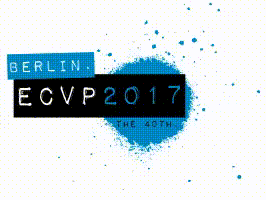Tutorials
Sunday, 27 August 2017, 13:00–16:00 h, all in parallel | at the conference venue Henry Ford Building | incl. in ECVP 2017 conference fee
Please note: Download tutorials-at-a-glance (PDF)
1. Our tutorials are open to ECVP 2017 participants only.
2. Please register by sending an e-mail to the tutor of the tutorial of your choice, and don't forget to add a copy of a proof that you are a registered ECVP 2017 participant.
3. Every tutorial needs a minimum number of participants to take place. Maximum number of participants: 20 (first come, first serve).
4. For tutorial rooms, please see below.
Introduction to Git and Github | register now | Multi purpose room I (Mezzanine)
Zampeta (Betty) Kalogeropoulou, HU Berlin
Git is a fast and flexible version control system, that keeps track of changes and history; who did what and when. At this tutorial, attendees will implement basic git features like stagging, adding and removing files, creating branches and tags. We will make groups and use Github in a team
environment to make pull requests. If possible bring a laptop, it will be an interactive workshop.
CANCELLED: Tools and workflows for local and global collaboration on scientific data
Michael Hanke, University of Magdeburg
There is a wealth of data available to scientific studies – public data, data provided by colleagues, and original data acquired in one's own lab. Reproducible research requires that scientific results are unambiguously associated with the data they were derived from. However, in practice this is often difficult to achieve. In particular data shared by 3rd-parties may change without notice when newly discovered problems get rectified. But also sub-optimal in-lab data management procedures can lead to hidden divergences of dataset copies.
In this tutorial attendees will be introduced to tools and workflows for data management, sharing, and re-use that guarantee a high level of transparency, reliability, and flexibility for common data management procedures. These include: data discovery across public and private data resources
(What data are available for a particular topic?); uniform data access across heterogeneous data portals and providers; accurate and reliable association of input data, analysis code, and derived results; publication of results with appropriate data provenance information.
At the end of this half-day workshop attendees will be able to package and share their own data, with colleagues or the public, in a form that promotes re-use and long-term availability, and to reliably track resources that are only available using the traditional some-zipfile-that-can-be-downloaded-somewhere approach.
Fully booked: Introduction to Psychopy | register now (waiting list) | Multi purpose room II (Mezzanine, next to kitchen)
Jonathan Peirce, University of Nottingham
This tutorial will introduce the basics of how to use PsychoPy and Python for vision science. PsychoPy is open-source, platform independent, easy to install and learn and provides an extremely flexible platform for running experiments. It has the unique advantage of both a scripting interface (similar to Psychtoolbox but using the Python language) and a graphical interface requiring little or no programming (ideal for teaching environments and simpler experiments). This tutorial will get you started with both interfaces, and show how the two can be used together by building a basic experiment visually and then customizing it with code. If possible, bring along a laptop with PsychoPy installed, so we can make it an interactive workshop, with live exercises.
Fully booked: Ideal Observer Models | register now (waiting list) | Conference room II (Konferenzraum II, upper floor)
Frank Jäkel, Psiori
The first part of the course is a short introduction to probability theory from a Bayesian perspective. In the second part of the course we will discuss why Bayesian Decision Theory provides a good starting point for probabilistic models of perception and cognition. The focus will be on Rational
Analysis and Ideal Observer models that provide an analysis of the task, the environment, the background assumptions and the limitations of the cognitive system under study.
Fully booked: Statistics of Signal Detection Models | register now (waiting list) | Conference room III (Konferenzraum III, upper floor)
Guillermo Aguilar, TU Berlin

Fully booked: Introduction to Single-Trial EEG analysis & Brain Computer Interfacing | register now (waiting list) | Senate Hall (Senatssaal, upper floor)
Benjamin Blankertz, TU Berlin
The aim of this lecture is to provide an illustrative tutorial on methods for single-trial EEG analysis. Concepts of feature extraction and classification will be explained in a way that is accessible also to participants with less technical background. Nevertheless all techniques required for state-of-the-art Brain-Computer Interfacing will be covered. The presented methods will be illustrated with concrete examples from the Berlin Brain-Computer Interface (BBCI) research project.
Fully booked: Bayesian Methods and Generative Models in Perception and Learning | register now (waiting list) | Lecture Hall D (Hörsaal D, upper floor)
Jozsef Fiser, Central European University
In the last decades, a significant shift occurred in vision research, with Bayesian methods emerging as an alternative to the once-dominant signal detection framework to model visual perception and learning. This tutorial will review the most important aspects of this new framework from the point of view of vision scientists. We will start with a motivation as to why Bayes, then continue with a quick overview of the basic concepts (uncertainty and probabilistic representations, basic equations), moving on to the main logic and ingredients of generative models including Bayesian estimation, typical generative models, belief propagation, and sampling methods. Next we will go over the details of some well-known examples of Bayesian modelling in perception and learning to see the argument and implementation of the probabilistic framework in action. Finally, we will have an outlook at the potential of the generative framework to capture vision, and what the new challenges are to be resolved by the next generation of modelers.







